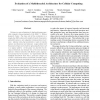46 search results - page 6 / 10 » Programming Living Cells to Function as Massively Parallel C... |
ICPP
2009
IEEE
14 years 2 months ago
2009
IEEE
—In an attempt to increase the performance/cost ratio, large compute clusters are becoming heterogeneous at multiple levels: from asymmetric processors, to different system archi...
SAS
1993
Springer
13 years 11 months ago
1993
Springer
Type and effect systems provide a safe and effective means of programming high-performance parallel computers with a high-level language that integrates both functional and impe...
CDES
2006
13 years 8 months ago
2006
: Over the last three decades there has been significant progress in the first principles methods for calculating the properties of materials at the quantum level. They have largel...
HPCA
2002
IEEE
14 years 7 months ago
2002
IEEE
Cyclops is a new architecture for high performance parallel computers being developed at the IBM T. J. Watson Research Center. The basic cell of this architecture is a single-chip...
MEMBRANE
2009
Springer
14 years 2 months ago
2009
Springer
em is a computing model, which abstracts from the way the living cells process chemical compounds in their compartmental structure. The regions defined by a membrane structure con...




